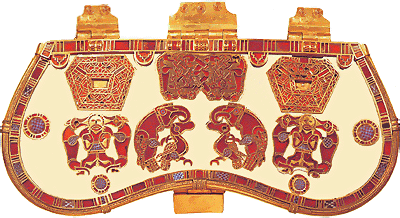|

|
|

Wearing Gold &
Garnets
 There
were many items of jewellery placed on the dead
person's
sarcophagus (big coffin) in the ship
burial at Sutton Hoo. There
were many items of jewellery placed on the dead
person's
sarcophagus (big coffin) in the ship
burial at Sutton Hoo.- The purse lid in the picture is
made of gold inlaid with ivory. It is covered in garnets (red
jewels) and blue glass.
- Can you see the birds-of-prey
attacking the ducks? And the wolves licking the men's faces? The
East Anglian Royal family were
called the Wuffingas. It means the 'wolf-men'.
- The cloth purse had rotted away.
The archaeologists found the coins it contained. There were 40,
dating from AD 625. There were also two small gold bars.
- There were golden shoulder clasps (click
for picture) completely covered in garnets and blue glass, using a technique
called 'cloisonné work'. They were also decorated with boars
(wild pigs). The clasps were used to keep clothing in place.
- We know there were clothes and wall
hangings in the burial chamber. Impressions of some of this were
found in pieces of rusted iron. Very tiny fragments of cloth had
also survived. They were brightly coloured: red, blue and
yellow.
- The dead person's belt had a big
buckle made of solid gold (click for
picture). It weighs nearly half a kilogram. It
is covered in an entwined thread pattern which is actually part
of two birds-of-prey. It is similar to other buckles found by
archaeologists, only much better quality.
- The sword-belt hung the dead
person's scabbard from his belt. It had 6 cloisonné work
mounts. There were also
cloisonné work strap ends.
- The 'Beowulf'
poem tells of the great
treasures placed in a ship funeral or burial.
- Activity
Sheet available.
|

